 Tuskegee Airmen National Historic Site at Moton Airfield, Alabama, was placed on the Register of Historic Landmarks in 1998 to preserve the site where the first African American pilots and maintainers of the US Armed Forces were trained during WWII. These men persevered against doubt and racism at every level to become one of the most respected fighter units in the European Theater, blazing the trail for full integration of the US military.
Tuskegee Airmen National Historic Site at Moton Airfield, Alabama, was placed on the Register of Historic Landmarks in 1998 to preserve the site where the first African American pilots and maintainers of the US Armed Forces were trained during WWII. These men persevered against doubt and racism at every level to become one of the most respected fighter units in the European Theater, blazing the trail for full integration of the US military.
Visitor Rating (write your own review below)
Our Weather. Clear skies and 70 degrees
Our Visit. I visited Tuskegee Airmen NHS while on a trip to nearby Montgomery, AL in March
“We were all prepared to fight and die for our country, and after the war. . . we were prepared to fight and die for our rights. . . I think that is the contribution that was made at Tuskegee” -George Lima, Tuskegee Airman
Overall Impression. While the Tuskegee Airmen proved their mettle more than 70 years ago, the preservation of Moton Airfield, the site of their primary training, has been undertaken relatively recently. While only a couple of hangars have been rebuilt and restored, those hangars are packed with history in a setting that balances modern museum displays with the preservation of rooms as they looked in their WWII days when history was being made. As someone who served in the US Air Force, this is hallowed ground. I’ve had the pleasure of meeting a couple of now departed Tuskegee Airmen, and I think they would be proud of the way their struggles and victories are being preserved for future generations.
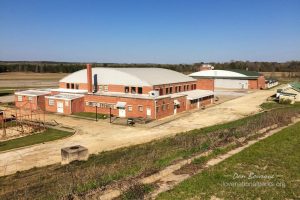
Hangar 1 as seen from the trail to the parking lot with Hangar 2 in the background. Note the wire-frame buildings in front of the hangar representing some of the original structures
Visiting. Tuskegee Airmen NHS is easy to visit as it’s only a couple miles from Interstate 85 east of Montgomery, AL just outside the town of Tuskegee, home to Tuskegee University. Plan at least one hour at this site, and in 2-3 hours, you can visit both Tuskegee Airmen NHS and the nearby Tuskegee Institute NHS on the University property. It’s fitting to visit these two sites together as the Tuskegee Institute, an early pillar of African American higher education and innovation, provided the airfield, personnel and much of the support for the Tuskegee Airmen during their training.
Start your tour from the overlook of the airfield adjacent to the parking lot. Moton Airfield is still an active airfield, so you can watch the occasional plane flying around. The heart of this site is the museum inside the two restored hangars, so after soaking in the view, take the short hike from the overlook to the hangars. One neat feature you’ll notice on your walk is a handful of “wire-frame buildings,” steel-tube outlines of some of the buildings of the original site that haven’t been restored.
The hangars are distinct, with Hangar 1 covering the stateside training at Moton Field and Hangar 2 covering the wartime operations and legacy of the Tuskegee Airmen. Hangar 1 is the most logical place to start. When you enter, look up to appreciate the period engineering that went into holding up massive hangar roofs with wooden beams. Around the hangar are dozens of displays including a full-scale Piper Cub and beautiful Stearman PT-17, the types used to train the hundreds of airmen including Benjamin O. Davis, Jr. who would later become the first black general in the US Air Force. Other displays chronicle the training regimen and difficulties faced by both the flyers and maintainers. Don’t miss the rooms off to the side, including the “War Room” with replicas of the books and training models used to prepare the airmen for their upcoming wartime missions. I was surprised by the amount of training material on the Pacific Theater knowing the “Red Tails” fought primarily in North Africa and Europe.
Hangar 2 chronicles the wartime record of the Tuskegee Airmen and is dominated by a red-tailed P-51 hanging menacingly from the ceiling. Displays illustrate where they fought, the types of missions they undertook, their hard-fought reputation (especially in bomber escort), and the honors they earned. Other displays illustrate the hardships they endured, from continued racism and doubts to having to steal parts from uncooperative supply depots to keep their machines in the air. You’re introduced to the Tuskegee Airmen’s goal of the “Double V”–victory both abroad and at home. While victory abroad happened first, the indisputable record these men established paved a clear path to the victory at home a few years later when the military was finally integrated. Take a few minutes and listen to some of the recordings of Tuskegee Airmen telling their stories.
Hangar 2 is also connected to the air traffic control tower, the only building on the site from the original 1941 field that is still standing. It’s worth the hike up a few flights of stairs to stand in the same room these airmen stood in decades before, but beware, there are wasps that call the tower home, though none of them seemed particularly aggressive.
Suggestions. This is a great place to bring kids, but there are a LOT of words on the displays. These words give a lot of context to the artifacts, but they might be tough for kids. Whether you have kids who are more enthralled with the visual displays or just don’t have enough time to read all the words, I recommend taking pictures of each display so you can read the full text later.
Nearby Towns Tuskegee, Montgomery (AL)
Other Nearby Attractions Tuskegee Institute NHS, Selma to Montgomery NHT, Horseshoe Bend NMP
Official NPS Website Tuskegee Airmen National Historic Site
- Near the parking lot is this overlook of the entire field
- Hangar 1 as seen from the entrance. Note the intricate wooden construction supporting the roof
- The slow but maneuverable Stearman PT-17 served as the primary trainer for the Tuskegee Airmen
- One of the dozens of displays featuring photos and informative text throughout the hangars
- The restored “War Room” where the Tuskegee Airmen studied about the foes they would soon be facing
- Ship models used to train the pilots in visual recognition
- Hangar 2 as seen from the entrance
- After a brief stint in obsolete P-40s, the Tuskegee Airmen transitioned to the P-51 to which they added their distinctive red tails
- View from the original control tower overlooking Moton Field
- Hangar 1 as seen from the trail to the parking lot with Hangar 2 in the background. Note the wire-frame buildings in front of the hangar representing some of the original structures
Write Your Own Review


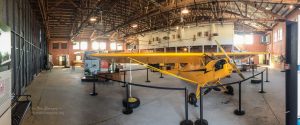
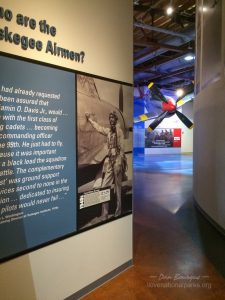

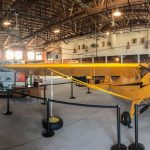
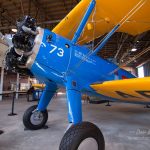
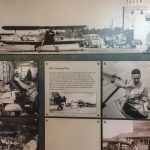
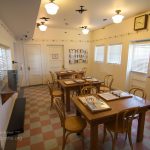
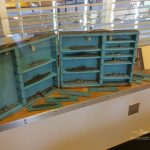
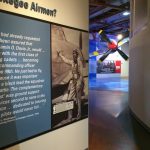
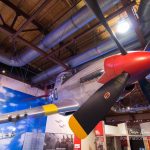
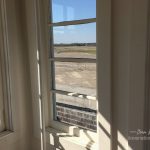

No Comments Yet